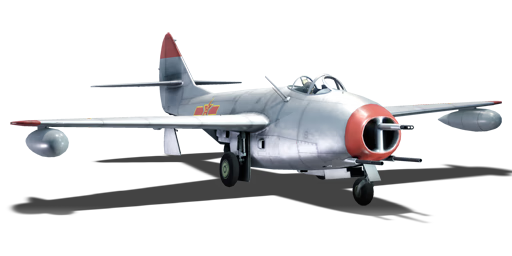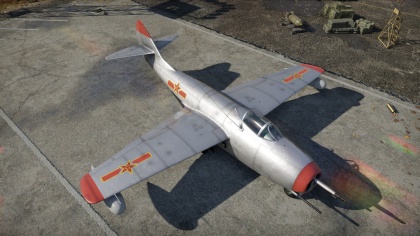MiG-9 (l) (China)
Contents
| This page is about the Chinese jet fighter MiG-9 (l) (China). For other uses, see MiG-9 (Family). |
Description
The ␗MiG-9 late is a rank Chinese jet fighter
with a battle rating of (AB), (RB), and (SB). It was introduced in Update 1.91 "Night Vision".
General info
Flight performance
Describe how the aircraft behaves in the air. Speed, manoeuvrability, acceleration and allowable loads - these are the most important characteristics of the vehicle.
| Characteristics | |||||||
|---|---|---|---|---|---|---|---|
| Stock | |||||||
| Max Speed (km/h at 1,000 m) |
Max altitude (meters) |
Turn time (seconds) |
Rate of climb (meters/second) |
Take-off run (meters) | |||
| AB | RB | AB | RB | AB | RB | ||
| ??? | ??? | ??.? | ??.? | ??.? | ??.? | 800 | |
| Upgraded | |||||||
| Max Speed (km/h at 1,000 m) |
Max altitude (meters) |
Turn time (seconds) |
Rate of climb (meters/second) |
Take-off run (meters) | |||
| AB | RB | AB | RB | AB | RB | ||
| ??? | ??? | ??.? | ??.? | ??.? | ??.? | 800 | |
Details
| Features | ||||
|---|---|---|---|---|
| Combat flaps | Take-off flaps | Landing flaps | Air brakes | Arrestor gear |
| X | ✓ | ✓ | X | X |
| Limits | ||||
|---|---|---|---|---|
| Wing-break speed (km/h) |
Gear limit (km/h) |
Combat flaps (km/h) |
Max Static G | |
| + | - | |||
| 480 | ~11 | ~4 | ||
| Optimal velocities | |||
|---|---|---|---|
| Ailerons (km/h) |
Rudder (km/h) |
Elevators (km/h) |
Radiator (km/h) |
| < 550 | < 600 | < 720 | N/A |
| Compressor (RB/SB) | ||
|---|---|---|
| Setting 1 | ||
| Optimal altitude | 100% Engine power | WEP Engine power |
| 0 m | 1,000 kgf | N/A |
Survivability and armour
Examine the survivability of the aircraft. Note how vulnerable the structure is and how secure the pilot is, whether the fuel tanks are armoured, etc. Describe the armour, if there is any, and also mention the vulnerability of other critical aircraft systems.
Armaments
Offensive armament
Describe the offensive armament of the aircraft, if any. Describe how effective the cannons and machine guns are in a battle, and also what belts or drums are better to use. If there is no offensive weaponry, delete this subsection.
Suspended armament
Describe the aircraft's suspended armament: additional cannons under the wings, bombs, rockets and torpedoes. This section is especially important for bombers and attackers. If there is no suspended weaponry remove this subsection.
Defensive armament
Defensive armament with turret machine guns or cannons, crewed by gunners. Examine the number of gunners and what belts or drums are better to use. If defensive weaponry is not available, remove this subsection.
Usage in battles
Describe the tactics of playing in the aircraft, the features of using aircraft in a team and advice on tactics. Refrain from creating a "guide" - do not impose a single point of view, but instead, give the reader food for thought. Examine the most dangerous enemies and give recommendations on fighting them. If necessary, note the specifics of the game in different modes (AB, RB, SB).
Pros and cons
Summarise and briefly evaluate the vehicle in terms of its characteristics and combat effectiveness. Mark its pros and cons in the bulleted list. Try not to use more than 6 points for each of the characteristics. Avoid using categorical definitions such as "bad", "good" and the like - use substitutions with softer forms such as "inadequate" and "effective".
Pros:
Cons:
History
Describe the history of the creation and combat usage of the aircraft in more detail than in the introduction. If the historical reference turns out to be too long, take it to a separate article, taking a link to the article about the vehicle and adding a block "/History" (example: https://wiki.warthunder.com/(Vehicle-name)/History) and add a link to it here using the main template. Be sure to reference text and sources by using <ref></ref>, as well as adding them at the end of the article with <references />. This section may also include the vehicle's dev blog entry (if applicable) and the in-game encyclopedia description (under === In-game description ===, also if applicable).
In-game description
An all-metal, single-seat cantilever monoplane with two turbojet engines, mid-mounted wings, and retractable tricycle landing gear.
It was clear by the end of World War II that the piston-engine-and-propeller combo had reached the limit of its potential. Soon it would be necessary to switch to new engine types.
Jet aviation in the USSR changed for the better at the very end of the war when captured German turbojet engines, particularly the BMW-003, arrived in the Soviet Union. The aforementioned engine was studied in the shortest time possible, and a Soviet copy, the RD-20, was launched into mass production.
In the end of 1945, the Mikoyan Design Bureau began the development of a jet fighter with two BMW-003 engines (producing 800 kg of thrust). On 24 April 1946, test pilot A.N. Grinchik first flew the prototype I-300 (F-1), the first Soviet fighter with a turbojet engine. The plane reached a speed of 920 km/h and had powerful armament: a 57mm N-57 cannon and two 23mm NS-23 cannons.
In 1946, the I-300 began full-scale production and was accepted for service with the Air Force under the designation of MiG-9 (Product FS). Before producing it on a full-scale basis, the designers of the Mikoyan Design Bureau reworked the fighter's construction (particularly its fuselage) from scratch to adapt it to production in large quantities.
The power unit of production MiG-9s consisted of two RD-20 turbojet engines producing 800 kg of thrust apiece. At first, planes of this model had RD-20A-1 engines, with a service life of 10 hours. Actually, these engines were captured BMW-003s, reassembled in the USSR. Subsequently, MiG-9s featured only Soviet-produced turbojet engines: the RD-20A-2, with a service life of 25 and 50 hours, and later the RD-20B, with a service life of 75 hours.
The armament of the production planes differed from that of the prototypes. The MiG-9 (Product FS) had one 37mm Nudelman N-37 cannon with 40 rounds and two 23mm Nudelman-Suranov NS-23K cannons with 80 rounds each.
In 1947, it was decided to equip the MiG-9 with RD-21 uprated engines producing 1,000 kg of thrust. The engine was uprated due to increased gas temperature and turbine revolutions.
A prototype I-307 (Product FF) aircraft was built and tested with these engines in 1947. The testing showed that the I-307 had higher flight characteristics than production MiG-9s. The I-307 remained a prototype, since in March 1948 a decision was made to start the full-scale production of the more advanced MiG-15.
The last production aircraft were handed over to the Air Force in December 1948, and in factories they were supplanted by a new plane from the Mikoyan Design Bureau, the MiG-15. A total of 602 MiG-9 fighters were produced.
The MiG-9 was the beginning of the jet MiG's history. The success of the MiG-15 fighter all over the world would have been impossible without the experience gained in the processes of design, building, testing, mass production, and operation of the first Soviet jet fighter, the MiG-9.
As new fighters were received by the Air Force, some MiG-9s would be delivered to China. These planes became the first jet fighters of the People's Liberation Army Air Force of China.
Media
Excellent additions to the article would be video guides, screenshots from the game, and photos.
See also
Links to the articles on the War Thunder Wiki that you think will be useful for the reader, for example:
- reference to the series of the aircraft;
- links to approximate analogues of other nations and research trees.
External links
Paste links to sources and external resources, such as:
- topic on the official game forum;
- encyclopedia page on the aircraft;
- other literature.
| Mikoyan-Gurevich Design Bureau (Микоя́н и Гуре́вич Опытное конструкторское бюро) | |
|---|---|
| Fighters | MiG-3-15 · MiG-3-15 (BK) · MiG-3-34 |
| I-225 | |
| Jet fighters | MiG-9 · MiG-9 (l) |
| MiG-15 · MiG-15bis · MiG-15bis ISh | |
| MiG-17 | |
| MiG-19PT | |
| MiG-21F-13 · MiG-21PFM · MiG-21S (R-13-300) · MiG-21SMT · MiG-21bis | |
| MiG-23M · MiG-23ML · MiG-23MLD | |
| MiG-27M · MiG-27K | |
| MiG-29 · MiG-29SMT | |
| Export/Licensed | ␗MiG-9 · ␗MiG-9 (l) |
| ◊MiG-15bis · ◔MiG-15bis · J-2* | |
| MiG-17AS · ◔MiG-17PF · J-4* · Shenyang F-5* | |
| ◊MiG-19S · J-6A* | |
| ◄MiG-21 SPS-K · ◊MiG-21MF · ◔MiG-21MF · ▄MiG-21bis · ◔MiG-21bis-SAU · ◊MiG-21bis-SAU · ◊MiG-21 "Lazur-M" · ▄MiG-21 Bison · J-7II** | |
| ◊MiG-23BN · ◊MiG-23MF · ◔MiG-23MF · ◊MiG-23MLA | |
| ◔MiG-29 · ◊MiG-29 · ◄MiG-29G | |
| *Licensed and domesticated with Chinese designations. | |
| **Unlicensed, reverse-engineered and domesticated with Chinese designations. | |
| See Also | Shenyang · Chengdu |
| China jet aircraft | |
|---|---|
| Fighters | J-2 · J-4 · J-6A · J-7II · J-7D · J-7E · J-8B · J-8F · J-10A · J-11 · J-11A |
| Strike aircraft | Q-5 early · Q-5A · Q-5L · JH-7A |
| Bombers | H-5 |
| France | ␗Mirage 2000-5Ei |
| USA | ␗F-84G-21-RE · ␗F-84G-31-RE · ␗F-86F-30 · ␗F-86F-40 · ␗F-100A · ␗F-100F · ␗F-104A · ␗F-104G · ␗F-5A · ␗F-5E · ␗F-16A MLU |
| USSR | ␗MiG-9 · ␗MiG-9 (l) |
| North Korea | Shenyang F-5 |
| Pakistan | A-5C · JF-17 |





